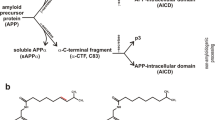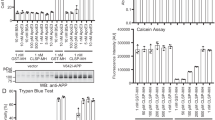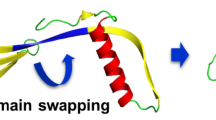Abstract
Using transgenic mice expressing human cystatin C (encoded by CST3), we show that cystatin C binds soluble amyloid-β peptide and inhibits cerebral amyloid deposition in amyloid-β precursor protein (APP) transgenic mice. Cystatin C expression twice that of the endogenous mouse cystatin C was sufficient to substantially diminish amyloid-β deposition. Thus, cystatin C has a protective role in Alzheimer's disease pathogenesis, and modulation of cystatin C concentrations may have therapeutic implications for the disease.
This is a preview of subscription content, access via your institution
Access options
Subscribe to this journal
Receive 12 print issues and online access
$209.00 per year
only $17.42 per issue
Buy this article
- Purchase on Springer Link
- Instant access to full article PDF
Prices may be subject to local taxes which are calculated during checkout


Similar content being viewed by others
References
Levy, E., Jaskolski, M. & Grubb, A. Brain Pathol. 16, 60–70 (2006).
Vinters, H.V., Nishimura, G.S., Secor, D.L. & Pardridge, W.M. Am. J. Pathol. 137, 233–240 (1990).
Maruyama, K., Ikeda, S., Ishihara, T., Allsop, D. & Yanagisawa, N. Stroke 21, 397–403 (1990).
Itoh, Y., Yamada, M., Hayakawa, M., Otomo, E. & Miyatake, T. J. Neurol. Sci. 116, 135–141 (1993).
Levy, E. et al. J. Neuropathol. Exp. Neurol. 60, 94–104 (2001).
Benussi, L. et al. Neurobiol. Dis. 13, 15–21 (2003).
Paraoan, L. et al. Traffic 5, 884–895 (2004).
Sastre, M. et al. Neurobiol. Aging 25, 1033–1043 (2004).
Pawlik, M. et al. J. Mol. Neurosci. 22, 13–18 (2004).
Hsiao, K. et al. Science 274, 99–102 (1996).
Sturchler-Pierrat, C. et al. Proc. Natl. Acad. Sci. USA 94, 13287–13292 (1997).
Levy, E., Lopez-Otin, C., Ghiso, J., Geltner, D. & Frangione, B. J. Exp. Med. 169, 1771–1778 (1989).
Gudmundsson, G., Hallgrimsson, J., Jonasson, T.A. & Bjarnason, O. Brain 95, 387–404 (1972).
Madero, M., Sarnak, M.J. & Stevens, L.A. Curr. Opin. Nephrol. Hypertens. 15, 610–616 (2006).
Ghidoni, R. et al. Neurobiol. Aging 28, 371–376 (2006).
Acknowledgements
We acknowledge financial support from the US National Institute of Neurological Disorders and Stroke (NS42029), National Institute on Aging (AG017617) and American Heart Association (0040102N). We thank M. Staufenbiel for APP23 transgenic mice, K. Hsiao Ashe for Tg2576 transgenic mice, and J. Berger and M. Mazzella for technical assistance.
Author information
Authors and Affiliations
Contributions
W.M., with the help of S.S.J., performed the experimental work with the exception of the histological analyses, which were done by D.S.R., A.M.K. and J.S., and ELISA analysis, which was performed by S.D.S. The crosses between CysC and APP transgenic mice were generated by M.P. with the help of M.S. R.A.N. and P.M.M. assisted in the manuscript preparation and data interpretation. E.L. designed and supervised the study, interpreted findings and finalized the manuscript preparation.
Corresponding author
Supplementary information
Supplementary Text and Figures
Supplementary Methods, Supplementary Figure 1 (PDF 253 kb)
Rights and permissions
About this article
Cite this article
Mi, W., Pawlik, M., Sastre, M. et al. Cystatin C inhibits amyloid-β deposition in Alzheimer's disease mouse models. Nat Genet 39, 1440–1442 (2007). https://doi.org/10.1038/ng.2007.29
Received:
Accepted:
Published:
Issue Date:
DOI: https://doi.org/10.1038/ng.2007.29
This article is cited by
-
Serum Cystatin C is a potential biomarker for predicting amyotrophic lateral sclerosis survival
Neurological Sciences (2024)
-
Human cystatin C induces the disaggregation process of selected amyloid beta peptides: a structural and kinetic view
Scientific Reports (2023)
-
Formaldehyde and Brain Disorders: A Meta-Analysis and Bioinformatics Approach
Neurotoxicity Research (2021)
-
Transcriptomic profiling of microglia and astrocytes throughout aging
Journal of Neuroinflammation (2020)
-
The Functional Mammalian CRES (Cystatin-Related Epididymal Spermatogenic) Amyloid is Antiparallel β-Sheet Rich and Forms a Metastable Oligomer During Assembly
Scientific Reports (2019)



